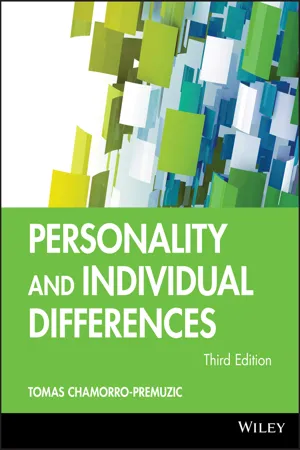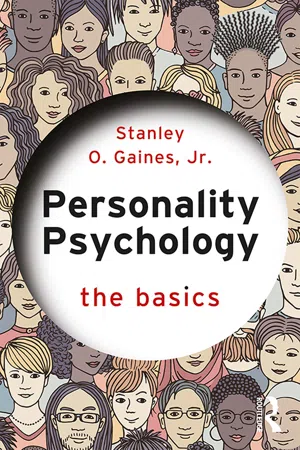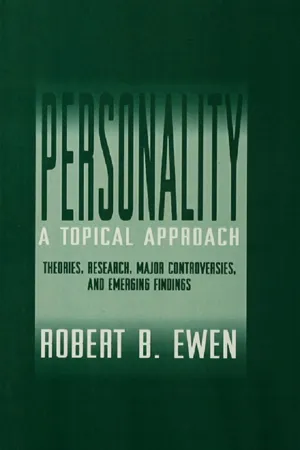Psychology
Trait Theory of Personality
The Trait Theory of Personality suggests that individuals possess certain enduring characteristics, or traits, that influence their behavior, thoughts, and emotions. These traits are relatively stable over time and across different situations, and they can be used to describe and predict an individual's behavior. Trait theory focuses on identifying and measuring these consistent patterns of behavior to understand and explain personality.
Written by Perlego with AI-assistance
Related key terms
1 of 5
11 Key excerpts on "Trait Theory of Personality"
- eBook - PDF
Personality
Theory and Research
- Daniel Cervone, Lawrence A. Pervin(Authors)
- 2018(Publication Date)
- Wiley(Publisher)
Likewise, personality researchers associated with the trait approach consider traits to be the major units of personality. Obviously, there is more to per- sonality than traits, but traits have loomed large throughout the history of personality psychology. The Trait Concept What, then, is a trait? Personality traits refer to consistent patterns in the way individuals behave, feel, and think. If we describe an individual with the trait term kind, we mean that this individual tends to act kindly over time (weeks, months, maybe years) and across situations (with friends, family, strangers, etc.). In addition, if we use the word kind, we usually mean that the person is at least as kind as the average person. If one believed that the person was less kind than average, he or she would not be described as “kind.” Trait terms, then, have two connotations: consistency and distinctiveness. By consistency, we mean that the trait describes a regularity in the person’s behavior. The person seems predisposed to act in the way described by the trait term; indeed, traits often are referred to as “dispositions” or “dispositional constructs” (e.g., McCrae & Costa, 1999, 2008) to capture the idea that the person appears predisposed to act in a certain way. The idea of disposition highlights an impor- tant fact about trait terms as used by trait theorists of personality. If a trait theorist uses a trait term—for example, sociable—to describe someone, she does not mean that the person always will act sociably, across all settings of life. As the Dutch trait psychologist De Raad (2005) has emphasized, trait terms implicitly refer to behaviors in a type of social context. The trait theorist would expect the sociable person to be consistently sociable across settings that involve other Trait Theory’s View of the Science of Personality 183 people and in which sociable behavior is allowed by prevailing social norms. - eBook - ePub
Personality Theories
Critical Perspectives
- Albert Ellis, Mike Abrams, Lidia Abrams(Authors)
- 2008(Publication Date)
- SAGE Publications, Inc(Publisher)
Chapter 9Personality and Traits
Chapter Goals- Explain the meaning and origin of the trait in personality theory
- Discuss how the trait approach to psychology both complements and competes with other perspectives
- Review the methods by which traits are discovered and tested
- Compare the leading trait models of personality
- Examine the biological and evolutionary basis of traits
Atraitin personality psychology can be generally defined as a component or distinguishing characteristic of an individual’s personality that is stable across time and external situations—although, as we shall see, different researchers have used the term in somewhat different ways.Trait psychologistsor trait theorists are those who regard human personality as being composed primarily of traits.The trait perspective has been criticized for its reductionist approach because it seems to be the very antithesis of humanistic psychology—of seeing humans as unified, free, conscious beings seeking self-fulfillment. Yet, a number of personality theorists, for example, Gordon Allport (1897–1967), have built bridges between humanistic psychology and trait theory, seeing traits as the means or medium through which individual uniqueness is expressed.Furthermore, and perhaps more important, trait theory is the single approach to personality theory that is most directly based on and corroborated by research data. Most personality theories pay at least lip service to the importance of empirical research, but trait theories can lay claim to being defined by it. The very usefulness of the concept of a trait is that it can be operationally defined and investigated through use of the scientific method. In this chapter, this operational approach is shown at work in the various definitions of traits. - eBook - PDF
- Tomas Chamorro-Premuzic(Author)
- 2015(Publication Date)
- BPS Blackwell(Publisher)
(b) Although some personality theorists have questioned the very idea of inter- nal traits, this concept represents the essence of personality research and differential psychology, as a robust empirical discipline is grounded on it. Furthermore, without the notion of traits it would be difficult to under- stand and predict human behavior across a variety of contexts. Thus Funder (2001, p. 213) has noted, “Someday a comprehensive history will be written of the permanent damage to the infrastructure of personality psychology wreaked by the person–situation debate of the 1970s and 1980s.” (c) Debate on the number of personality traits that are needed to classify individual differences has dominated research since the early days of Eysenck and Cattell, two major figures in the field whose contributions to personality theory and research are unmatched. Eysenck’s biological theory of personality comprised three main dimensions – Neuroticism, Extraversion, and Psychoticism – and is still widely used in differential research, although the biological aspects of the theory seem outdated and the conceptualization of Psychoticism remains contested. Cattell’s approach, based on the lexical hypothesis (the assumption that all aspects of personality can be mapped onto existing words and language), was abandoned on psychometric grounds, but gave birth to the current reigning taxonomy, the Five Factor or Big Five model. (d) Despite the lack of explanatory power of the Big Five framework (in particular compared to Eysenck’s more causal theory), the robust psychometric properties of self-report inventories such as the NEO- PI-R (Costa & McCrae, 1985, 1992) have persuaded most differential psychologists to conceptualize personality in terms of five supertraits – Neuroticism, Extraversion, Openness to Experience, Agreeableness, and Conscientiousness – as well as their underlying primary facets. - eBook - PDF
Psychology of Personality
Viewpoints, Research, and Applications
- Bernardo J. Carducci(Author)
- 2015(Publication Date)
- Wiley(Publisher)
nomothetic approach The study of common traits by comparing the personality of different people. organizational psychology The study of principles of psychology applied to behavior in work settings. personal dispositions Traits that are unique to the indi- vidual. personalism An approach to psychology emphasizing the study of the person. personalistic An emphasis on the understanding of the individual. psychoticism A basic personality type identified by Eysenck and characterized by varying degrees of personality pathology. Q-data Information about an individual obtained from questionnaires and personality inventories. secondary traits Personal dispositions that influence an individual’s behavior in very specific situations. Sixteen Personality Factor Questionnaire (16PF) A per- sonality inventory used to assess major source traits. source traits Underlying psychological dispositions that influence behavior across a wide variety of situations. specific responses Behaviors observed in particular situ- ations. Study of Values Scale A measure of the six basic human values identified by Allport. surface traits Interrelated forms of behavior serving as observable evidence for the presence of certain under- lying traits. T-data Information about an individual obtained while observing the person in specific situations. temperament traits Manifestations of an individual’s general behavioral style. traits For Eysenck, a set of related behaviors performed across a variety of situations. trait A psychological construct assumed to predispose people to respond in a particular manner. type For Eysenck, the grouping together of related traits. - eBook - ePub
Personality Psychology
The Basics
- Stanley Gaines Jr.(Author)
- 2019(Publication Date)
- Routledge(Publisher)
5TRAIT PERSPECTIVES ON PERSONALITY
In Chapter 1 , we learned about Gordon Allport’s (1937/1951, 1961/1963) psychology of the individual, including G. W. Allport’s pioneering version of trait theory . Legend has it that G. W. Allport developed trait theory largely as the result of an uncomfortable encounter that he experienced with Sigmund Freud, who apparently responded to G. W. Allport’s recounting of an incident that he had just witnessed on a train ride (in which a little boy and the boy’s mother seemed to be excessively concerned with keeping dirt off the boy’s clothing) with the none-too-rhetorical question, “And was that little boy you?” (Ewen, 1998). From that day onward, G. W. Allport allegedly had little use for Freud’s “depth psychology”, opting instead for a direct approach to learning about the core aspects of individuals’ personalities: Just ask individuals what they are like (C. S. Hall & Lindzey, 1957).In principle, G. W. Allport and Odbert’s (1936) exhaustive reading of an unabridged English-language dictionary yielded a list of approximately 18,000 trait terms, which could be narrowed to “only” 4,500 or so terms after synonyms and antonyms are taken into account (Ewen, 1998). However, in practice, G. W. Allport (1928) developed a survey to measure only one trait – specifically, “ascendance/submission”, which corresponds roughly to dominance (i.e., individuals’ tendency to behave in a manner that is intended to benefit themselves; Wiggins, 1979). In retrospect, G. W. Allport chose his construct well; every trait survey that we will review in the present chapter includes either “pure” dominance or, arguably, a blend of dominance with another trait (typically nurturance , or individuals’ tendency to behave in a manner that is intended to benefit persons other than, or in addition to, themselves; see Gaines, 2016/2018).In the present chapter, we will consider trait perspectives on personality, in the tradition of G. W. Allport (1937/1951, 1961/1963). As we will see, trait perspectives were subjected to withering criticism during the 1960s – most notably from Walter Mischel (1968), who contended that a particular trait usually explains no more than 9–10% of variance in behaviour across individuals (Snyder & Ickes, 1985). By the same token, we will learn about various strategies that trait theorists have pursued in order to address (and, in some instances, to overtly refute) challenges from Mischel and other critics concerning the traditional (i.e., dispositional - eBook - PDF
- Spencer Rathus, , , (Authors)
- 2021(Publication Date)
- Cengage Learning EMEA(Publisher)
It was believed that they would restore the balance of bodily “humors.” Early in the 20th century, Gordon Allport and a colleague (Allport & Oddbert, 1936) catalogued some 18,000 human traits from a search through word lists like dictionaries. Some were physical traits such as short, weak, and brunette. Others were behavioral traits such as shy and emotional. Still others were moral traits such as honest. This exhaustive list has served as the basis for personality research by many other psychologists. 10-2b HANS EYSENCK’S TRAIT THEORY British psychologist Hans J. Eysenck (1916–1997) focused much of his research on the relationships between two personality traits: introversion – extraversion and emotional stability–instability (Eysenck & Eysenck, introversion a trait characterized by intense imagination and the tendency to inhibit impulses extraversion a trait characterized by tendencies to be socially outgoing and to express feelings and impulses freely 10-2c THE “BIG FIVE”: THE FIVE-FACTOR MODEL More recent research suggests that there may be five basic personality factors, not two. These include the two found by Eysenck— extraversion and neuroticism —along with conscientiousness , agreeableness , and openness to experience (see Table 10.1). Many personality theorists, especially Robert McCrae and Paul T. Costa Jr. (2013), played a role in the devel-opment of the five-factor model. Cross-cultural research has found that these five factors appear to define the personality structure of American, German, Portuguese, Israeli, Chinese, Korean, Japanese, and Philippine people (Katigbak et al., 2002; McCrae & Costa, 1997). A study of more than 5,000 German, British, Spanish, Czech, and Turkish people sug-gests that the factors are related to people’s basic temperaments, which are considered to be largely inborn (de Moor et al., 2012). - Philip J. Corr, Gerald Matthews(Authors)
- 2020(Publication Date)
- Cambridge University Press(Publisher)
Purely descriptive trait measures, of course, beg the question of whether the developmental origins and dynamic implica- tions of those measured traits are comparable in the normal and abnormal populations. Humanists, including Abraham Maslow (1976), advo- cated studying the healthy personality, not only those who are disturbed. The popular movement called positive psychology continues the theme from humanistic psych- ology, focusing on understanding and promoting healthy and creative human potentials and psychological well- being (Gable & Haidt, 2005; Seligman & Csikszentmihalyi, 2000; Seligman, Steen, Park & Peterson, 2005). Development: Continuity and Change Over Time Personality theories address development in various ways. Does the passage of time simply reveal innate personality as it unfolds (as biological and many trait approaches imply), or provide opportunities for change (as learning theories suggest)? Do people develop in a gradual, con- tinuous way or through discontinuous stages (as Erikson’s psychosocial theory outlines)? Are there critical or sensi- tive stages, when experience has a particularly strong influence (as psychoanalytic and attachment theories describe)? Longitudinal research, which is needed to address ques- tions of change or continuity, is challenging, but fortu- nately some major longitudinal studies enlighten us about personality continuity and change, including ego- control (Block & Block, 2006), and emotionality and self- regulation (Kubzansky, Martin & Buka, 2004). Stability from childhood to adulthood, while significant in many cases, is low enough to suggest that significant change occurs, especially before adulthood (Caspi, Roberts & Shiner, 2005; Hampson & Goldberg, 2006). In addition, by tracking individuals, longitudinal studies can help avoid misleading results from correlational and short- term studies because of different trajectories for various individuals (e.g., toward health, as discussed by Friedman & Kern, 2014).- eBook - PDF
- Richard Ryckman(Author)
- 2020(Publication Date)
- Cengage Learning EMEA(Publisher)
(Adapted from The Biological Basis of Personality, by H. J. Eysenck, 1967, p. 36. Courtesy of Charles C. Thomas, Publisher, Ltd., Springfield, Illinois.) 244 Part 3: Trait Perspectives Copyright 2013 Cengage Learning. All Rights Reserved. May not be copied, scanned, or duplicated, in whole or in part. Due to electronic rights, some third party content may be suppressed from the eBook and/or eChapter(s). Editorial review has deemed that any suppressed content does not materially affect the overall learning experience. Cengage Learning reserves the right to remove additional content at any time if subsequent rights restrictions require it. is based on observed intercorrelations among traits such as sociability, impulsivity, activity, liveliness, and excitability. Each of these traits is inferred from intercorrelated habitual responses such as going to parties, liking to talk to people, going to films on the spur of the moment, and so forth. These habits are themselves inferred from observable specific responses—actual occasions when the person went to a party, talked to people, and so forth. On the basis of numerous factor analyses of personality data gathered from different study participant populations all over the world, Eysenck derived two factors that could readily be labeled introversion/extraversion and stability/neuroticism. Later, on the basis of other statistical analyses, he postulated a third dimension, impulse control/psychoti- cism (Eysenck, 1982, p. 9). These three dimensions, according to Eysenck, are the major individual difference types most useful in describing personality functioning. Once he had identified the three primary dimensions, Eysenck proceeded to construct a paper-and-pencil test to measure them. The original test is the Eysenck Personality Questionnaire (EPQ) (Eysenck & Eysenck, 1975). - No longer available |Learn more
Psychology Applied to Modern Life
Adjustment in the 21st Century
- Wayne Weiten, Dana Dunn, Elizabeth Hammer(Authors)
- 2014(Publication Date)
- Cengage Learning EMEA(Publisher)
The study uncov- ered some interesting findings. For example, participants’ extraversion correlated with the volume of brain regions known to process reward. Variations in neuroticism corre- lated with the volume of brain areas known to be activated by threat, punishment, and negative emotions. And the size of brain areas thought to regulate planning and voluntary control correlated with subjects’ degree of conscientious- ness. This line of research is brand new, but the promising initial results suggest that it may be fruitful to explore the neurological bases of personality traits. The Evolutionary Approach to Personality In the realm of biological approaches to personality, the most recent development has been the emergence of an evolutionary perspective. Evolutionary psychologists as- sert that the patterns of behavior seen in a species are products of evolution in the same way that anatomical characteristics are. Evolutionary psychology examines behavioral processes in terms of their adaptive value for members of a species over the course of many gen- erations. The basic premise of evolutionary psychology is that natural selection favors behaviors that enhance organ- isms’ reproductive success—that is, passing on genes to the next generation. Evolutionary theorists assert that per- sonality has a biological basis because natural selection has favored certain personality traits over the course of human history (Figueredo et al., 2005, 2009). Thus, evolu- tionary analyses of personality focus on how various traits—and the ability to recognize these traits in others— may have contributed to reproductive fitness in ancestral human populations. For example, David Buss (1991, 1995) has argued that the Big Five personality traits stand out as important di- mensions of personality across a variety of cultures be- cause those traits have had significant adaptive implica- tions. - eBook - PDF
- Catherine A. Sanderson, Karen R. Huffman(Authors)
- 2019(Publication Date)
- Wiley(Publisher)
Walter Mischel in 1968 was one of the first psychologists to suggest that behaviors are determined more by situations than by the personality traits a person possesses—a position now called situationism. As you can imagine, this theory sparked considerable attention within the scientific community, which later became known as the person/situation debate. Today, most personality psychologists agree that both the person and situation are important. The current dominant theory is interactionism, meaning that behaviors are determined by an interaction between situations and the personality traits a person possesses. Stability vs. Change Now that we’ve agreed on interactionism, other questions arise— are our personalities stable or can they change? The answers are complex. Some research shows considerable stability in personality traits, whereas others have shown that under some circumstances personality does change. One study of newlyweds’ personalities found that over the first 18 months of marriage, husbands showed significant declines in extraversion and agreeableness and a significant increase in conscientiousness (Lavner et al., 2018). In contrast, the wives showed significant declines in agreeableness, neuroticism, and openness. Can you see how this study illustrates not only that personality can change, but also that it does so naturally over time and in new situations (e.g., marriage)? Considering the natural changes over time, researchers studied data from participants who took personality tests in high school and then took the same test 50 years later (Damian et al., 2019). They found that on average participants became more conscientious, more emotionally stable, and more agree- able over time. However, those who were most conscientious as teenagers remained more con- scientious than their peers 50 years later. This study illustrates how personality does change somewhat, but differences also remain over time. - eBook - ePub
Personality: A Topical Approach
Theories, Research, Major Controversies, and Emerging Findings
- Robert B. Ewen(Author)
- 2013(Publication Date)
- Psychology Press(Publisher)
5 Trait Theory: Controversies and Emerging FindingsEven the most dedicated trait theorist would agree that Allport’s list of 4,000–5,000 traits is unmanageable. It seems reasonable to conclude that human nature cannot be this diverse, and that there must be a much smaller number of traits that represent the core of personality.Some theorists and researchers have focused their attention on that they regard as important. Others have used complicated mathematical procedures to try and reduce Allport’s list to a few fundamental traits. We will consider each of these approaches in the pages that follow.Selected Traits Introversion-ExtraversionJung’s Theory. Carl Jung attributed individual differences in personality to two processes: the typical way in which we apprehend internal and external stimuli, and the characteristic direction (inward or outward) of libido movement.There are four ways to apprehend stimuli (functions): merely establishing what is there (sensation), interpreting and understanding the meaning of what you perceive (thinking), evaluating how desirable or pleasant it is (feeling), and forming apparently inexplicable hunches or conclusions without using any of the other functions (intuition). “Sensation tells you that something exists; thinking tells you what it is; feeling tells you whether it is agreeable or not; and intuition tells you whence it comes and where it is going” (Jung, 1964/1968, p. 49). Thinking and feeling are opposites, and are called rational functions because they involve acts of cognition and judgment. Sensation and intuition are also opposites, and these more reflexive functions are referred to as irrational (meaning nonrational, not pathological). Although everyone has the ability to use all four functions, there is an inborn tendency for one of them to become dominant over the others.There are also two directions of libido movement (attitudes). The outward turning of libido toward the external world is known as extraversion, while the flow of libido toward the depths of one’s own psyche is referred to as introversion
Index pages curate the most relevant extracts from our library of academic textbooks. They’ve been created using an in-house natural language model (NLM), each adding context and meaning to key research topics.










